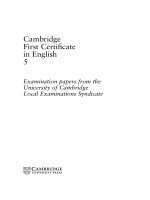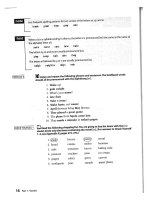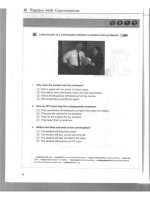Success step english 5 pps
Bạn đang xem bản rút gọn của tài liệu. Xem và tải ngay bản đầy đủ của tài liệu tại đây (115.41 KB, 6 trang )
Square
Measuring the area and perimeter of a square is basi-
cally the same as a rectangle, only the length and width
are the same measurement.
Area: side × side
Perimeter: side × 4
Triangle
Remember that a triangle is half a rectangle.
Area:
ᎏ
1
2
ᎏ
b × h. Multiply the height and the base.
Since the triangle is half, divide by two. Note:
The height of a triangle is not always one of the
sides. For example, in triangle ABC which fol-
lows, side AB is not the height, BD is the height.
AC is the base. To find the area, ignore all the
numbers but the base and the height. The base
can be found by adding 4 and 8: 4 + 8 = 12. The
height is 5.
ᎏ
1
2
ᎏ
× 5 × 12 =
ᎏ
6
2
0
ᎏ
or 30.
Perimeter: Add the sides all around: 12 + 6 + 9 = 27
Circle
The diameter of a circle goes from one point on the
circle, through the middle, and all the way across to
another point on the circle. The radius (r) is half of the
diameter. When working with π, consider the follow-
ing: The symbol π is usually found in the answers so
you don’t have to worry about converting it to a num-
ber. But if π is not found in the answers, and the ques-
tion calls for an approximate answer, substitute 3 for π.
The question may tell you to use
ᎏ
2
7
2
ᎏ
or 3.14.
Area: πr
2
. Square the radius and look at the answers.
If π is not found in the answers, multiply by 3. In
the example above, A = π4
2
or 16π.
Circumference: 2πr. Circumference is to a circle what
perimeter is to a rectangle. Multiply the radius by
2 and look for the answers. If π is not in the
answer choices, multiply by 3. In the example
above, the circumference is 2π4, or 8π.
Other Areas
Cut the figure into pieces, find the area of each, and
add. If you’re asked to find the area of a figure with a
piece cut out of it, find the area of the whole figure,
find the area of the piece, and subtract.
Other Perimeters
For any perimeter, just add the outside lengths all the
way around.
Practice
8. Find the area of a circle with a diameter of 6.
a. 36π
b. 24π
c. 16π
d. 9π
e. 6π
–CBEST MINI-COURSE–
108
9. What is the area of the triangle above?
a. 48
b. 9
c. 12
d. 18
e. 24
10. A box measured 5′′ wide,
ᎏ
1
2
ᎏ
′ long, and 4′′ high.
How many one-inch cube candies could fit in
the box?
a. 10 candies
b. 60 candies
c. 90 candies
d. 120 candies
e. 150 candies
Answers
8. d. If the diameter is 6, the radius is 3. A = π(3)
2
= 9π.
9. c. 8 is the base, b, and 3 is the height, h.
ᎏ
1
2
ᎏ
× 8
× 3 = 12.
10. d. The words “one-inch cube” are there to throw
you off; volume is always measured in one unit
cubic space. Since
ᎏ
1
2
ᎏ
foot = 6 inches: 6 × 4 × 5 =
120.
Math 6: Ratios, Proportions,
and Percents
Ratios and proportions, along with their cousins, per-
cents, are reportedly on every CBEST. A good under-
standing of these topics can help you pick up valuable
points on the math section of the test.
The Three-Step Ratio
The three-step ratio asks for the ratio of one quantity
to another.
Sample Three-Step Ratio Question
Use the three steps above to help you work out the fol-
lowing problem.
1. Which of the following expresses the ratio of 2
yards to 6 inches?
a. 1:3
b. 3:1
c. 1:12
d. 9:1
e. 12:1
Answer
1. One yard is 36 inches, so 2 yards is 72 inches.
Thus, the ratio becomes 72:6. (The quantities can
also be put in yards.)
2. This ratio can be expressed as
ᎏ
7
6
2
ᎏ
or 72:6. In this
problem, 72:6 is the form that is used in the
answers.
3. Since the answer is not there, reduce. 72 inches: 6
inches = 12:1. The answer is e. Notice that choice
c, 1:12, is backwards, and therefore incorrect.
Three Success Steps
for Three-Step Ratios
1. Put the quantities in the same units of meas-
urement (inches, yards, seconds, etc.).
2. Put the quantities in order and in the form
given by the answer choices.
3. If the answer you come up with isn’t a choice,
reduce.
–CBEST MINI-COURSE–
109
Practice
Try the three steps on the following problems.
2. Find the ratio of 3 cups to 16 ounces.
a. 2:3
b. 3:16
c. 16:3
d. 3:1
e. 3:2
3. Find the ratio of 6 feet to 20 yards.
a. 10:1
b. 6:20
c. 3:10
d. 20:6
e. 1:10
4. Find the ratio of 2 pounds to 4 ounces.
a. 2:4
b. 2:1
c. 1:8
d. 8:1
e. 8:5
5. In a certain class, the ratio of children who pre-
ferred magenta to chartreuse was 3:4. What was
the ratio of those who preferred magenta to the
total students in the class? Hint: Add 3 and 4 to
get the total.
a. 7:3
b. 3:4
c. 4:3
d. 3:7
e. 4:7
6. In a certain factory, employees were either fore-
men or assembly workers. The ratio of foremen
to assembly workers was 1 to 7. What is the ratio
of the assembly workers to the total number of
employees?
a. 1:7
b. 7:1
c. 7:8
d. 8:7
e. 2:14
Answers
2. e.
3. e.
4. d.
5. d.
6. c.
The Four-Step Ratio
The four-step ratio solution is used when there are two
groups of numbers: the ratio set, or the small numbers;
and the actual, real-life set, or the larger numbers. One
of the sets will have both numbers given, and you will
be asked to find one of the numbers from the other set.
HOT TIP
■
You can almost do question 2 by the process of
elimination. You know that 3:16 or 16:3 can’t be
right because the units haven’t been converted yet.
You also know that test makers like to turn the cor-
rect ratio around in order to try to catch you, so a or
e must be the answer. If you know that 3 cups is
more than 16 ounces, you have it made.
■
In question 3, b and c are the same quantity. There
can’t be two right answers, so they can be elimi-
nated. Why change yards into feet? Six feet is two
yards. Reducing 2:20 makes 1:10. Aren’t these fun?
–CBEST MINI-COURSE–
110
Sample Four-Step Ratio Question
7. The ratio of home games won to total games
played was 13 to 20. If home teams won 78
games, how many games were played?
Answer
This problem can be solved in four steps.
1. Notice there are two categories: home team wins
and total games played. Place one category over
the other in writing.
ᎏ
T
H
o
o
t
m
al
e
ga
w
m
in
e
s
s
ᎏ
or
ᎏ
H
T
ᎏ
Note: This step is frequently omitted by test
takers in order to save time, but the omission of
this step causes most of the mistakes made on
ratio problems. If you reversed the H and T, put-
ting T on top, that is not wrong, as long as you
make sure to put the total games on top on both
sides of the equation.
2. In the problem above, the small ratio set is com-
plete (13 to 20), and you’re being asked to find the
larger, real-life set. Work with the complete set
first. Decide which numbers from the complete
set go with each written category. Be careful; if
you set up the ratio wrong, you will most proba-
bly get an answer that is one of the answer
choices, but it will be the wrong answer.
Notice which category is mentioned first: “The
number of HOME games won to TOTAL games
played . . .”Then check to see what number is first:
“. . . was 13 to 20.” Thirteen is first, so 13 goes with
home games; 20 goes with the total games.
ᎏ
H
T
ᎏ
=
ᎏ
1
2
3
0
ᎏ
3. Determine whether the remaining number in the
problem best fits home wins or total games. “If
home teams won 78 games” indicates that the 78
goes in the home-team row. The number of total
games played isn’t given, so that spot is filled with
an x.
ᎏ
H
T
ᎏ
=
ᎏ
1
2
3
0
ᎏ
=
ᎏ
7
x
8
ᎏ
4. Now cross multiply. Multiply the two numbers on
opposite corners: 20 × 78. Then divide by the
number that is left (13).
ᎏ
20
1
×
3
78
ᎏ
=
ᎏ
1,
1
5
3
60
ᎏ
= 120
Practice
Try the four steps on the following problems.
HOT TIP
After you cross multiply and wind up with one fraction,
you can divide a top number and the denominator by the
same factor and thus avoid long computations. In the
above example, 13 ÷ 13 = 1 and 78 ÷ 13 = 6.
The problem would then be much simpler: 20 × 6 = 120.
Four Success Steps
for Four-Step Ratios
1. Label the categories of quantities in the prob-
lem to illustrate exactly what you’re working
with.
2. Set up the complete set in ratio form.
3. Set up the incomplete set in ratio form.
4. Cross multiply to get the missing figure.
–CBEST MINI-COURSE–
111
20
1
78
13
=
120
×
6
8. On a blueprint,
ᎏ
1
2
ᎏ
inch equals 2 feet. If a hall is
supposed to be 56 feet wide, how wide would the
hall be on the blueprint?
a. 1
ᎏ
1
6
ᎏ
b. 4
ᎏ
2
3
ᎏ
c. 9
ᎏ
1
3
ᎏ
d. 14
e. 18
ᎏ
2
3
ᎏ
9. In a certain recipe, 2 cups of flour are needed to
serve five people. If 20 guests were coming, how
much flour would be needed?
a. 50
b. 30
c. 12
d. 10
e. 8
10. A certain district needs 2 buses for every 75
students who live out of town. If there are 225
students who live out of town, how many buses
are needed?
a. 4
b. 6
c. 8
d. 10
e. 11
Answers
8. d.
9. e.
10. b.
Percents
There are only five basic types of percent problems on
the CBEST. These will be explained below. As is true
with most other types of problems on the CBEST, per-
cent problems most often appear in word-problem
format. Percents can be done by using ratios or by alge-
bra. Since ratios have just been covered, this section
will explain the ratio method.
Percents can be fairly simple if you memorize
these few relationships:
ᎏ
o
is
f
ᎏ
,
ᎏ
w
p
h
a
o
rt
le
ᎏ
,
ᎏ
pe
1
r
0
ce
0
nt
ᎏ
.
–CBEST MINI-COURSE–
112
Eight Success Steps for
Solving Percent Problems
Feel free to skip steps whenever you don’t need
them.
1. Notice the numbers. Usually you are given two
numbers and are asked to find a third. Are you
given the whole, the part, or both (
ᎏ
w
p
h
a
o
r
l
t
e
ᎏ
)? Is the
percent given (
ᎏ
pe
1
r
0
c
0
ent
ᎏ
)? Is the percent large or
small? Is it more or less than half? Sometimes
you can estimate the answer enough to elimi-
nate some alien answers.
2. If there are pronouns in the problem, write the
number to which they refer above the pronoun.
3. Find the question and underline the question
word. Question words can include how much
is, what is, find, etc. In longer word problems,
you may have to translate the problem into a
simple question you can use to find the
answer.
4. Notice the verb in the question. The quantity
that is by itself on one side of the verb is con-
sidered the is. Place this number over the
number next to the of ( ). If a question word
is next to an is or of, put a variable in place of
the number in that spot. If there is no is or no
of, check to see whether one is implied. See
whether you can rephrase the question, keep-
ing the same meaning, but putting in the miss-
ing two-letter word. If all else fails, check to
make sure the part is over the whole.
5. Place the percent over 100. If there is no per-
cent, put a variable over 100 (
ᎏ
pe
1
r
0
c
0
ent
ᎏ
).
6. Make the two fractions equal to each other.
7. Solve as you would a ratio.
8. Be sure to answer the question that was
asked.
is
ᎏ
of
Sample Question:
Finding Part of a Whole
11. There are 500 flights out of Los Angeles every
hour. Five percent are international flights. How
many international flights leave Los Angeles
every hour?
Answer
1. You are being asked to find a part of the 500
flights. The 500 flights is the whole. The percent
is 5. You need to find the part. 5% is fairly small,
and considering that 20% of 500 is 100, you
know your answer will be less than 100.
2. The second sentence has an implied pronoun.
The sentence can be rephrased “Five percent of
them are international flights.” “Them” refers to
the number 500.
3. The question is “How many ”Use the other
sentences to reconstruct the question so it
includes all the necessary information. The
problem is asking “5% of 500 (them) are how
many (international flights)?” The question is
now conveniently set up.
4. “Are” is the verb. 500 and 5% are on the left side
of the verb and “how many” is on the right side.
“How many” is all by itself, so it goes on top of
the ratio in the form of a variable. 500 is next to
the of so it goes on the bottom. At this point,
check to see that the part is over the whole.
ᎏ
50
x
0
ᎏ
=
5. The 5 goes over 100.
ᎏ
50
x
0
ᎏᎏ
1
5
00
ᎏ
6. The two are equal to each other.
ᎏ
50
x
0
ᎏ
=
ᎏ
1
5
00
ᎏ
7. Solve.
8. 25 international flights leave every hour.
Sample Question: Finding the Whole
12. In a certain laboratory, 60%, or 12, of the mice
worked a maze in less than one minute. How
many mice were there in the laboratory?
Answer
Once again, follow the eight Success Steps to solving
this problem.
1. 12 is part of the total number of mice in the lab-
oratory. 60 is the percent, which is more than
half. 12 must be more than half of the whole.
2. There are no pronouns.
3. The problem is asking, “60% of what number
(total mice) is 12?”
4. “Is” is the verb. The 12 is all by itself on the right
of the verb.“What number” is next to the of.The
12 goes on top, the variable on the bottom.
ᎏ
1
x
2
ᎏ
5. The 60 goes over 100.
ᎏ
1
6
0
0
0
ᎏ
6. The two fractions are equal to each other.
ᎏ
1
x
2
ᎏ
=
ᎏ
1
6
0
0
0
ᎏ
7. Solve.
8. There were 20 mice in the laboratory.
Sample Percent Question
13. Courtney sold a car for a friend for $6,000. Her
friend gave her a $120 gift for helping with the
sale. What percent of the sale was the gift?
3
1
==
20
12 100
60
×
12 100
60
×
4
5
500
1
5
100
==
25
×
500 5
100
×
5
–CBEST MINI-COURSE–
113









